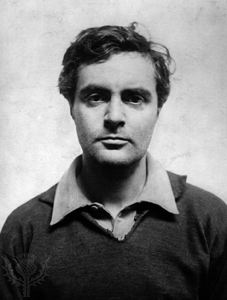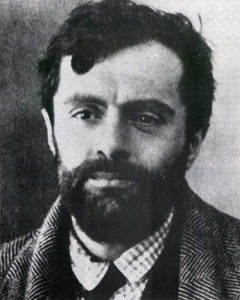Amedeo Modigliani is one of the ten most “faked” artists ever, with at least a thousand forgeries of his work floating about at any given time–that is, according to Meryle Secrest’s excellent new biography entitled Modigliani – A Life. Not to worry, because the author also points out the sure-fire way to detect a real Modigliani from a fake. If you take a good look at Modigliani’s under-painting (assuming you have an x-ray unit nearby), the facial details are always “drawn in large and violent rings of brown paint,” giving you a perfect idiosyncratic signature.
But Secrest’s book is not about forgeries; it’s about myth busting, primarily the myth that portrayed Modigliani mainly as a dissipated alcoholic and drug addict who painted strange elongated faces, most likely when under the influence. Through strong research Secrest dispels this two-dimensional notion by pointing out the real reason behind the artist’s ever increasing use of drink and drugs that ended with his death at the age of thirty-five, without a single tooth left in his mouth.
His death was due to tubercular meningitis, not a dissolute life style. No doubt the artist drank and took drugs to excess, rather de rigueur for most artists at that time when such things were legal and easily obtained. But Secrest shows us why Modigliani indulged even beyond what was considered normal for his fellow bohemians. She portrays a man working overtime to avoid the stigma of having tuberculosis. She puts forth convincing evidence that his heavy drinking and drug use, particularly opium with laudanum, which he used as an antispasmodic to suppress his fits of coughing and later as an analgesic to relieve his pain, were out of necessity.
Modigliani’s tuberculosis developed into tubercular meningitis, which affects the brain causing severe headaches and wide mood swings. This would have caused strange behavior, which, coupled with his ever-increasing alcohol and drugs to damper his suffering, guaranteed the myth that would define him. Yet even at the time few knew the reason for his overindulgence.
“Dedo,” as he was usually called, was famously handsome, sensitive, likable, gregarious and intelligent. Involved in numerous affairs with women, the book concentrates at length on the three primary females in his life. There’s the short relationship with the Russian Anna Akhmatova; later, the more serious affair with the English Beatrice Hastings; and finally his life with the young beautiful French girl Jeanne Hebuterne, who gave him a daughter. Modigliani died on a Saturday night and on Monday at three a.m. Jeanne, heavily pregnant with another child from Modigliani, walked backward out of a sixth-floor window to her death.
The book also covers Modigliani’s two dealers, Paul Guillaume and Leopold Zhorwski, as well as the numerous artists who floated with him around Montmartre and later Montparnasse. Two of the most significant artists were Soutine, another physical wreck (a ruined digestive system and liver from years of drinking and semi-starvation), and Brancusi, who understandably influenced him since Modigliani had wanted to be a sculptor above all else. Besides Brancusi’s effect and influence, other artists and art movements hardly moved him, not the Fauves, not the Nabis, not even the explorations of Braque, Matisse or Picasso; Modigliani went his own way.
The book spares little: You read about his carefree manner with money, his skipping out of debts, his shabby studios, all is there. And what of Jeanne Modigliani, his surviving daughter from Jeanne Hebuterne? She’s covered as well. What’s lacking, from an otherwise formidable book, is analysis of his art coupled with adequate examples of his paintings. There is no shortage of the splendid photographs one expects to find in an artist’s biography, but which, as in most such texts, fail to render an artist’s works as significant as his life experiences. Solution? Find a second book to fill the void. In this particular case I used Phaidon’s Modigliani by Douglas Hall.
After the success of Modigliani’s London show at the Mansard Gallery, his works began to sell well, but by then he had little time left before his death. Meryle Secrest used two terms in her book, “rara avis” (rare bird) and “vie maudite” (cursed life), which pretty much epitomize the man’s life, the cursed life of a rare bird named Amadeo (“Beloved of God”).




Dear René:
I read and enjoyed your Modigliani piece and your bio/interview.
I just love your Sun and Moon sculpture!
Keep at it. It fills me with joy to see how beautifully your work is evolving.
Much love always,
Desy
Rene, so glad you have a blog up. Thanks for letting us know about the new book.
GOOD WRITING, INFORMATIVE!
Thanks, Rene. Sounds like an interesting biography of an unfortunate life. To be beloved of God can be as much a curse as a blessing, it appears. I think of that other Amade(us)–Wolfgang. On an unrelated note, I wonder if others share my difficulty in reading white on dark?
Rene, again, well written, it makes me want to read the book. Your Moon and Sun piece is my favorite of your pieces, but the rest of your work is also impressive. Wunderbar!
Renata
Thank you Rene. I love your reviews and I love the new site for them.